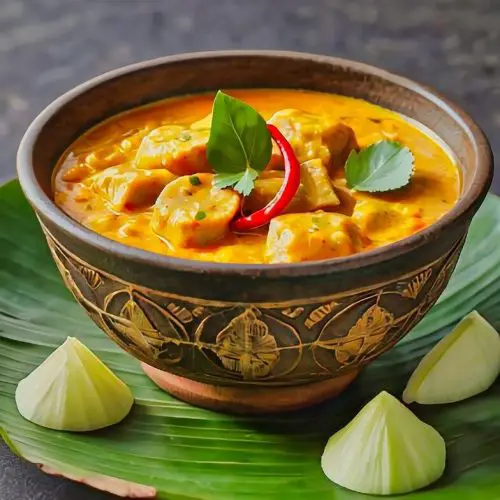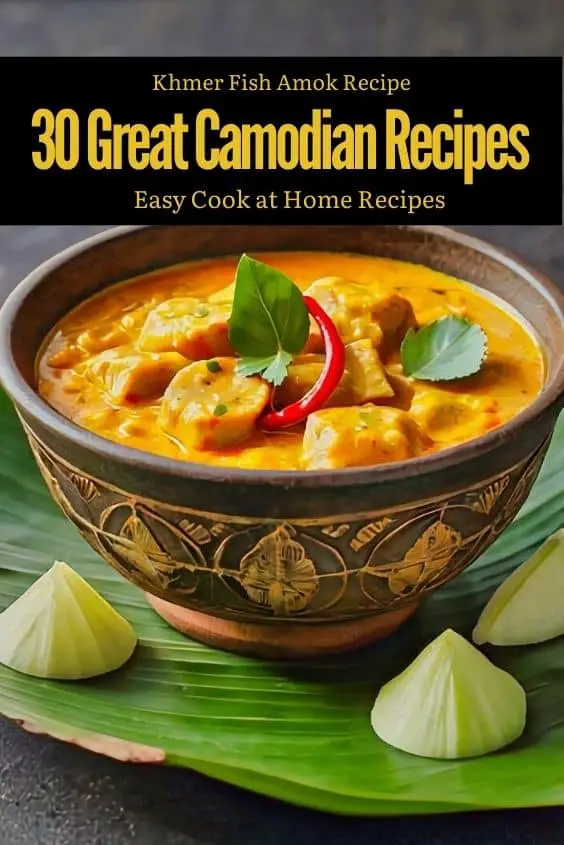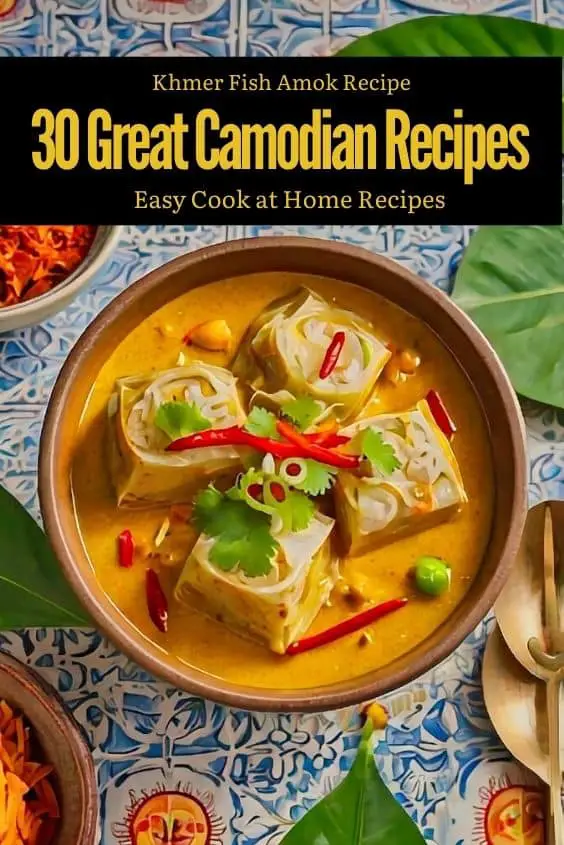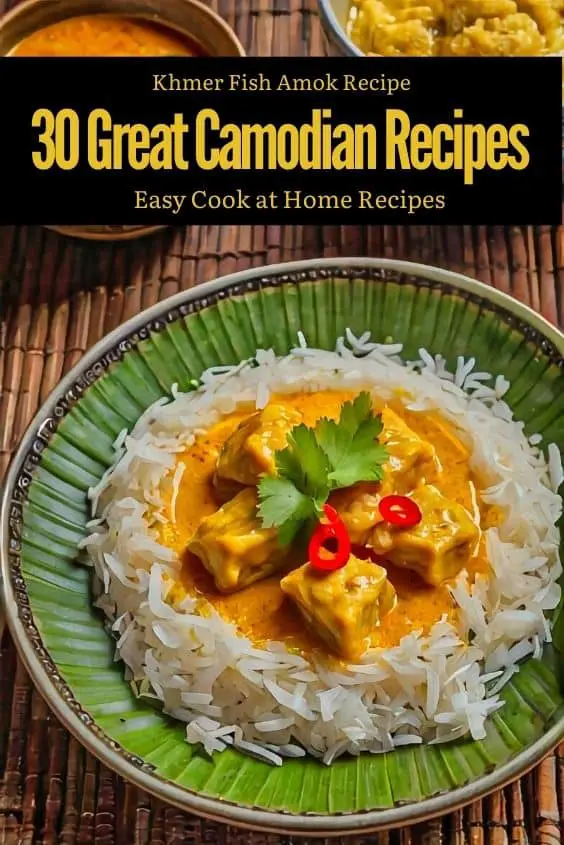Cambodian Fish Amok Recipe is a dish that features fish steamed in a rich, thick coconut milk-based sauce. The fish is cut into bite-sized pieces and then coated with a mixture that includes coconut milk, kroeung paste (a blend of herbs and spices), and eggs. The resulting texture is creamy and smooth, with the fish remaining tender throughout the cooking process.
The sauce in the Cambodian Fish Amok Recipe has a velvety consistency, thanks to the coconut milk and eggs, which help bind the ingredients together. It clings to the fish, creating a uniform layer of rich, flavorful coating. The fish itself maintains its firmness, yet becomes tender from the steaming, allowing it to easily flake apart when eaten.
Visually, the Cambodian Fish Amok Recipe has a soft golden-yellow color, often due to the turmeric in the kroeung paste. The dish is typically served in a banana leaf, which is folded into a small bowl-like shape, containing the fish and sauce mixture. This presentation enhances the dish’s visual appeal, but the focus remains on the creamy, well-blended sauce and tender fish pieces.
The makeup of the Cambodian Fish Amok Recipe ensures that the sauce is thick enough to hold its shape, even after steaming, while still being light enough to allow the delicate flavor of the fish to come through. The dish is mild yet flavorful, with a balance between the creamy sauce and the flaky fish texture, making it both visually and texturally appealing.
Ingredients For the Cambodian Fish Amok Recipe
White Fish Fillets
Coconut Milk
Red Curry Paste
Fish Sauce
Palm Sugar
Lime jJuice
Kaffir Lime Leaves
Vegetable Oil
Lemongrass
Garlic
Shallots
Galangal
Shrimp paste
Cilantro leaves
Red Chili slices
Cooking Instructions For the Cambodian Fish Amok Recipe
- The red curry paste, fish sauce, palm sugar, lime juice, and kaffir lime leaves should all be mixed together in a plate. Blend thoroughly by stirring.
- Second, in a skillet over medium heat, warm the vegetable oil. Put the galangal (or ginger), shallots, garlic, lemongrass, and lemongrass into the pan. Continue to sauté for another two or three minutes, or until the aroma begins to waft.
- Return the combination of curry paste to the pan and continue cooking, stirring continuously, for an additional 2 minutes.
- Add the coconut milk and boil for a few minutes.
- Carefully place the fish pieces into the skillet and cover them with the sauce. Once the fish is done and soft, cover the pan and simmer for around 10 to 12 minutes.
- Add additional lime juice or fish sauce to taste if you feel the sauce needs more flavor.
- If you’d like to add shrimp paste, do it now and simmer for one more minute.
- Take the Fish Amok from the stove and put it in bowls or cups made of banana leaves. Toss in some sliced red chile and some fresh cilantro leaves for garnish, if you want.
- Steamed rice or rice noodles are great accompaniments to the Fish Amok.
How Do I Properly Use Prahok (Cambodian Fermented Fish Paste) in Home-Cooked Meals?
Prahok, a staple in Cambodian cooking, is a strong-smelling, fermented fish paste that adds a deep umami flavor to various dishes. Though its pungency can be intense, when used correctly, it brings a unique complexity to your meals.
To start, prahok is often used in small quantities due to its strong flavor. It can be added directly to dishes like stir-fries, soups, and stews to enhance the overall taste. For example, in traditional dishes such as Samlor Machu Kroeung (a Cambodian sour soup), prahok is blended into the broth to provide a savory balance to the tangy tamarind and lemongrass flavors.
For beginners, incorporating prahok into a sauce or marinade can be a more approachable method. Combine a small amount of prahok with ingredients like lime juice, garlic, and chili to make a dipping sauce for grilled meats or vegetables. This allows you to control its intensity while enjoying its distinctive taste.
If you’re cooking a stir-fry, like Prahok Ktis (stir-fried pork with prahok), sauté the prahok with aromatics such as garlic, shallots, and lemongrass to mellow its strong scent. The paste blends well with the richness of coconut milk, helping to balance its saltiness.
Remember, prahok is an acquired taste, so start with smaller amounts and adjust to your liking. Over time, it will become a key element in recreating the authentic flavors of Cambodian cuisine at home.
10 Reasons Why I Love Cambodian Food
1. Bold Flavors – Cambodian food masterfully blends salty, sour, sweet, and bitter flavors in a single dish. This balance creates a dynamic eating experience that keeps your taste buds engaged. Each dish is full of surprises.
2. Fresh Herbs and Vegetables – Cambodian dishes make extensive use of fresh ingredients like cilantro, lemongrass, and basil. These herbs provide a refreshing and vibrant flavor that enhances the natural taste of the food. It’s a burst of freshness in every bite.
3. Variety of Textures – From the crunch of fresh vegetables to the chewiness of rice noodles, Cambodian cuisine offers a delightful variety of textures. This mix keeps each dish interesting and satisfying. You’re never bored with just one texture.
4. Healthy Cooking Techniques – Cambodian food often uses methods like steaming, grilling, and light stir-frying. These techniques help retain nutrients while keeping the dishes light and flavorful. You get great taste without feeling heavy.
5. Cultural Influence – Cambodian cuisine is a beautiful fusion of flavors influenced by Thai, Vietnamese, and Chinese cooking. This mix of cultures brings depth to the food, making each dish feel like a journey through history.
6. Unique Ingredients – Cambodian dishes often feature special ingredients like prahok (fermented fish paste) and galangal. These bold and distinctive ingredients give Cambodian food a flavor profile that stands out. It’s truly unforgettable.
7. Variety in Dishes – Whether it’s soups, stir-fries, or grilled meats, Cambodian cuisine offers an incredible range of dishes. You can find something for every palate, from mild to spicy, and everything in between.
8. Street Food Scene – The street food in Cambodia is lively and offers a wide variety of quick, tasty bites. From skewers to noodles, the flavors of Cambodian street food are as exciting as they are accessible. It’s food on the go, done right.
9. Affordability – Cambodian food is simple yet full of flavor, often using inexpensive ingredients. This makes it easy and affordable to recreate at home without needing fancy or expensive products. Great food doesn’t have to break the bank.
10. Delicious Desserts – Cambodian desserts are light, sweet, and often use tropical fruits and coconut. From sticky rice to banana-based sweets, they offer a pleasant, refreshing way to end a meal. The perfect balance of sweet and satisfying.
Create a 200 word post describing: Types of vegetables are commonly used in Cambodian cooking with descritions of how they are used?
Essiential Ingredients for Cooking Cambodian Food at Home
To truly embrace the essence of Cambodian cuisine at home, it’s important to understand the essential ingredients that form the backbone of this vibrant cooking tradition. Cambodian dishes are all about balance — combining salty, sweet, sour, and bitter flavors in harmony. Below are the key ingredients that make this balance possible, along with how they are used in some traditional recipes.
One of the cornerstones of Cambodian cooking is fish sauce, a pungent yet indispensable condiment that adds saltiness and depth to a variety of dishes. Used much like salt in Western cooking, fish sauce enhances the flavors of soups, stir-fries, and marinades. In Samlor Machu Kroeung (a traditional sour soup), fish sauce is stirred into the broth to provide a rich, savory undertone that balances the sourness of tamarind. Fish sauce also makes its way into dipping sauces, commonly served alongside grilled meats.
Equally important in Cambodian cuisine is palm sugar, a natural sweetener that tempers the saltiness and acidity in many dishes. Extracted from sugar palm trees, this ingredient is used to balance bold flavors. For example, in Amok Trey, a steamed fish curry, palm sugar is mixed with coconut milk, fish sauce, and Kroeung (a Cambodian spice paste) to create a rich, well-rounded flavor profile that melds sweetness with a creamy base. Palm sugar is also essential in desserts like Num Plae Ai, sweet sticky rice balls stuffed with coconut and palm sugar filling.
Lemongrass is a fresh, citrusy herb that gives Cambodian food its distinct brightness. Typically bruised or finely chopped, lemongrass is a key component of Kroeung, a spice paste used in many soups and curries, like Samlor Korko. The herb’s aromatic oils are released when pounded, adding a zesty freshness that balances the heavier flavors of fish sauce and fermented pastes.
In addition to lemongrass, galangal plays a major role in creating Cambodian spice pastes. Although it resembles ginger, galangal has a more peppery, intense flavor that adds depth to dishes. Sliced or grated, it’s commonly used in curries like Samlor Kari (Cambodian red curry), where its sharp, earthy flavor balances out the richness of coconut milk.
Perhaps one of the most unique Cambodian ingredients is prahok, a fermented fish paste that is both divisive and essential. It has a strong, salty flavor and is often used sparingly to avoid overpowering dishes. Prahok is key in Prahok Ktis, a popular dish made by frying the paste with minced pork, coconut milk, and lemongrass, creating a savory, creamy dish that pairs well with fresh vegetables and rice.
Kaffir lime leaves are another aromatic that imparts a citrusy, fragrant note to Cambodian food. These leaves are typically torn or crushed and added to soups, stews, and curries, providing a bright, slightly floral flavor. In dishes like Samlor Machu Yuon (a Vietnamese-style sour soup), the kaffir lime leaves elevate the broth with their distinct aroma.
To create the sour component found in many Cambodian dishes, tamarind paste is often used. Tamarind adds a tangy flavor to soups, sauces, and even dipping condiments. For instance, in Samlor Machu Kroeung, tamarind is combined with lemongrass, prahok, and galangal to give the soup its signature sourness, balanced by the salty fish sauce.
Cambodian food is also known for its vibrant yellow hue in certain curries, thanks to turmeric. Fresh or powdered turmeric lends an earthy, slightly bitter flavor and a bright color to dishes like Amok Trey. The spice is often used in combination with lemongrass and galangal to create a robust curry paste.
Dried shrimp is another common ingredient that adds a concentrated, salty flavor to Cambodian salads, soups, and sauces. Ground or rehydrated, it is used in dishes like Bok L’hong (green papaya salad), where it enhances the dish with its umami notes, complementing the fresh vegetables and tangy dressing.
Finally, coconut milk is essential in many Cambodian curries and soups. Its rich, creamy texture tempers the heat from chili and the tang from tamarind, creating a smooth, luxurious base for dishes like Samlor Kari and Amok Trey. Coconut milk also plays a role in desserts, offering a sweet, creamy balance to ingredients like palm sugar and sticky rice.
These ingredients form the foundation of Cambodian cooking and are key to recreating its unique flavors at home. Whether you’re preparing a rich curry, a tangy soup, or a savory stir-fry, having these essentials on hand will help you achieve the complex, balanced taste that defines Cambodian cuisine.
FAQ For the Cambodian Fish Amok Recipe
Q: What is the Cambodian Fish Amok recipe?
A: The Cambodian Fish Amok recipe is a traditional dish where fish is steamed in a rich, coconut-based curry, typically served in banana leaf cups.
Q: What kind of fish is used in the Cambodian Fish Amok recipe?
A: The Cambodian Fish Amok recipe commonly uses freshwater fish like catfish or snakehead fish, but you can also use other white fish like tilapia or cod.
Q: What ingredients are essential for the Cambodian Fish Amok recipe?
A: The essential ingredients for the Cambodian Fish Amok recipe include fish, coconut milk, kroeung (Cambodian spice paste), eggs, fish sauce, and kaffir lime leaves.
Q: How long does it take to cook the Cambodian Fish Amok recipe?
A: The Cambodian Fish Amok recipe takes about 45 minutes to 1 hour to prepare, including time for making the kroeung paste and steaming the fish.
Q: Can I substitute the fish in the Cambodian Fish Amok recipe with another protein?
A: Yes, while the Cambodian Fish Amok recipe traditionally uses fish, you can substitute it with chicken, tofu, or shrimp for a different variation of the dish.

Cambodian Fish Amok
Equipment
- A medium-sized pan with a lid
- A cutting board and knife
- A spoon or spatula for stirring
- Measuring cups and spoons
- A grater for ginger
Ingredients
- 1 lb fish such as snapper or catfish, cut into bite-sized pieces
- 16 oz coconut milk 400 ml coconut milk
- 2 tbsp red curry paste
- 2 tbsp fish sauce
- 1 tbsp palm sugar or brown sugar
- 1 tbsp tablespoon lime juice
- 2 kaffir lime leaves thinly sliced (optional)
- 2 tbsp vegetable oil
- 1 tbsp lemongrass chopped
- 1 tbsp garlic minced
- 1 tbsp shallots
- 1 tbsp shrimp paste optional
- - Fresh cilantro leaves for garnish
- - Fresh red chili slices for garnish (optional)
Instructions
- In a bowl, combine the red curry paste, fish sauce, palm sugar, lime juice, and kaffir lime leaves. Stir until well combined.
- Heat the vegetable oil in a pan over medium heat. Add the lemongrass, garlic, shallots, and galangal (or ginger) to the pan. Sauté for 2-3 minutes until fragrant.
- Add the curry paste mixture to the pan and cook for another 2 minutes, stirring constantly.
- Pour in the coconut milk and bring the mixture to a simmer.
- Gently add the fish pieces to the pan, making sure they are submerged in the sauce. Cover the pan and let it simmer for about 10-12 minutes until the fish is cooked through and tender.
- Taste the sauce and adjust the seasoning if needed by adding more fish sauce or lime juice.
- Optional: If using shrimp paste, stir it in at this stage and cook for an additional minute.
- Remove from heat and serve the Fish Amok in bowls or banana leaf cups. Garnish with fresh cilantro leaves and sliced red chili, if desired.
- Enjoy the Fish Amok with steamed rice or rice noodles.





3 comments
I have tried the Fish, Shrimp and Chicken and I cant decide which I like best.
I never knew fish amok could be so easy to make! But should we really be using canned coconut milk instead of fresh? I feel like it might compromise the authentic taste. What do you guys think?
Im not convinced that using coconut milk is essential for Fish Amok. I think there could be room for experimentation with different ingredients to achieve a unique flavor profile.
Comments are closed.